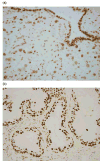Polycyclic aromatic hydrocarbon-DNA adduct formation in prostate carcinogenesis
- PMID: 16154258
- PMCID: PMC1761147
- DOI: 10.1016/j.canlet.2005.07.029
Polycyclic aromatic hydrocarbon-DNA adduct formation in prostate carcinogenesis
Abstract
The evidence for polycyclic aromatic hydrocarbons (PAH) playing a role in prostate carcinogenesis comes mainly from associations between reported PAH exposures and prostate cancer in epidemiologic studies. Associations between prostate cancer and DNA repair genotypes and phenotypes have also been reported, lending further credence to a PAH-induced carcinogenesis pathway in prostate cancer. Recent work that demonstrates the human prostate has metabolic enzyme activity necessary for PAH activation and will form DNA adducts upon exposure to PAH further supports PAH carcinogenesis. We have demonstrated the presence of PAH-DNA adducts in prostate cancer cases, but further validation of this biomarker as a carcinogenic agent in human prostate is needed.
Figures


References
-
- Yang SK, Silverman BD, editors. Polycyclic Aromatic Hydrocarbon Carcinogenesis: Structure-activity Relationships. CRC Press; Boca Raton, FL: 1988.
-
- Tolbert PE. Oils and cancer. Cancer Causes Control. 1997;8:386–405. - PubMed
-
- Phillips DH. Polycyclic aromatic hydrocarbons in the diet. Mutat Res. 1999;443:139–147. - PubMed
-
- Shimada T, Yamazaki H, Foroozesh M, Hopkins NE, Alworth WL, Guengerich FP. Selectivity of polycyclic inhibitors for human cytochrome P450s 1A1, 1A2, and 1B1. Chem Res Toxicol. 1998;11:1048–1056. - PubMed
-
- Scherer G, Frank S, Riedel K, Meger-Kossien I, Renner T. Biomonitoring of exposure to polycyclic aromatic hydrocarbons of nonoccupationally exposed persons. Cancer Epidemiol Biomarkers Prev. 2000;9:373–380. - PubMed
Publication types
MeSH terms
Substances
Grants and funding
LinkOut - more resources
Full Text Sources
Other Literature Sources
Medical

